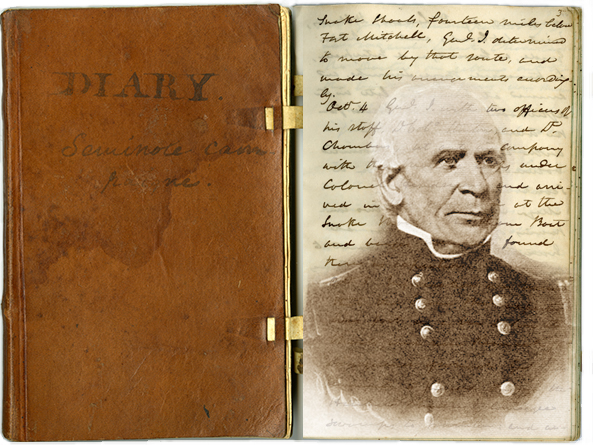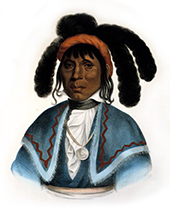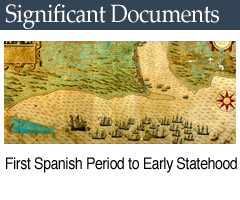Thomas Sidney Jesup Diary

Thomas Sidney Jesup commanded military operations in Florida during the early stages of the Second Seminole War (1835-1842).
This diary, from the collections of the State Library and Archives of Florida, includes his personal account of the conflict from October 1, 1836, to May 30, 1837.
Jesup replaced Richard Keith Call in October 1836 and thereafter took command of federal troops, state militia, and bands of friendly Creek Indians participating in military operations on the Florida peninsula. His orders were to locate hostile Seminoles in their strongholds between the Hillsborough and Withlacoochee Rivers and compel them to emigrate west of the Mississippi River.

Portrait of Chief Micanopy
The diary describes Jesup’s campaign movements across the Florida frontier, communications with officers, and the requisition of supplies. Because Jesup served as Quartermaster General for the United States military, the diary covers the development of forts and military outposts. Jesup also comments on the condition of troops, the difficulties of maneuvering through the Florida wilderness, and his own complications from wounds suffered during the War of 1812.
The diary reveals Jesup’s personal thoughts about the campaign, particularly regarding relations with Seminole leaders. After his Army skirmished with the Indians and took hostages from their camps, Jesup met and negotiated with several prominent Seminole leaders including Micanopy, Alligator, Jumper and Cloud. Through these meetings, Jesup realized that Florida Indians had very diverse views on removal.
The diary illustrates Jesup’s frustrations with the leaders’ reluctance to assemble their people, and at the same time, describes their ability to live in the otherwise inhospitable terrain of Southern Florida. Jesup discusses his reasoning behind policies towards Indian property, especially African-American slaves, who Seminoles intended to bring with them west of the Mississippi. Although Jesup viewed all Africans living among the Seminoles as slaves, his perception oversimplified the status of many of the African-Americans living among Florida Indians. While some Africans were held in bondage by Seminole masters, some attained important positions within the tribe, such as Abraham, the advisor and interpreter for Micanopy.
Most importantly, this diary shows Jesup’s role as the key mediator between the War Department in Washington and Florida Indians during the Second Seminole War. The diary covers Jesup’s correspondence with the Secretary of War and the Adjutant General, who pushed for immediate removal, as well as talks with hesitant Indian leaders. Jesup’s fear of being deceived by the Indians, particularly when the leaders failed to arrive for talks on February 18, 1837, is evident throughout the diary. This diary serves as an important primary source for understanding the difficulties faced by the United States military as it attempted to implement Indian Removal in Florida.
Significant Entries
1836
- November 27
- Jesup learns of his appointment as commander of all U.S. troops operating in Florida against the Seminoles.
- December 3
- Lieutenant Colonel David Caulfield captures 41 black Seminoles after destroying their towns near the Ocklawaha River.
- December 24
- Jesup writes to Creek leader Echo Harjo requesting that he provide 100 warriors for the campaign against the Seminoles.
1837
- January 24
- Jesup reports an engagement in which the Seminole leader Cooper (Osuchee) is killed and 17 of his people captured.
- February 10
- Jesup reports the death of John Caesar, one of the principal black Seminole leaders.
- March 5-6
- Holatoochee, Jumper, Cloud and other Seminole leaders inform Jesup that they intend to bring their property (cattle, slaves) with them if they agree to emigrate. Jesup declares that all Indians found north of the Hillsborough River will be considered hostile. Jesup agrees to compensate Seminoles for their cattle, and to allow blacks to accompany them west.
- Jesup receives information from Powell that the Miccosukees will not surrender and will likely resume hostilities.
- May 28
- Jesup is informed that Micanopy has been replaced by Sam Jones (Abieka) as the principal leader of the Seminoles.
See more significant entries »

 Listen: The Bluegrass & Old-Time Program
Listen: The Bluegrass & Old-Time Program


